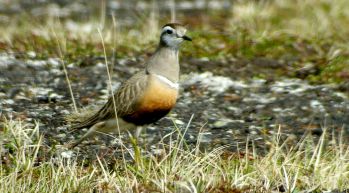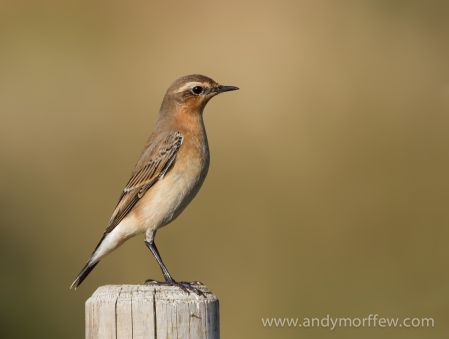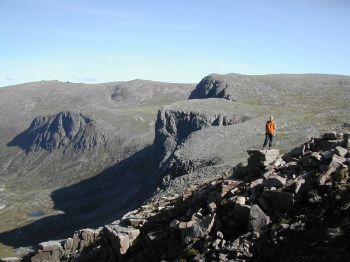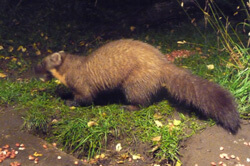Another delightful and very attractive spring arrival to our high mountains is the Dotterel. Like the first snows, my first sighting each spring is always a “marker” in the mountain year. Both sexes sport a distinctive pastel chestnut/orange breast and above the eyes a crown of dark feathers bordered by a broad white strip. Up close they are a very striking bird.

Photo Caption: A dotterel – often seen in the Spring in the high Cairngorms when out hiking with Scot Mountain Holidays
Photo Credit: Åsa Berndtsson
Like the Ring Ouzel and the Wheatear, it winters in Morocco. They migrate in groups known as ‘trips’ and then move into their territories as the snow thaws and with nesting beginning in mid May. They nest is a shallow scrape in the ground lined with moss and lichens. With the Dotterel the roles are reversed, they are one of only 22 species worldwide where the male does all the incubation of the eggs. He often does all the rearing of the young as well whilst the female may well move onto another territory, sometime as far as Norway, and mate again. In Scotland it nests above 700m in the Cairngorms and quite often well above 1000m and down to 550m in NW Sutherland which corresponds with the descent of the alpine vegetation zone.
Early in the season when the birds have just arrived they will often allow you to get remarkably close – to within 4 feet on one occasion! This having been said they are susceptible to disturbance and despite there striking plumage are often well camouflaged against the pink granite and gravel of the Cairngorm Plateau. To the unaware hillwalker with his/her head down you may only be aware of them once it’s too late. Be alert to the possible presence of this bird when you’re on the high tops and if you do spot any movement ahead, immediately stop and check it out. If it is a Dotterel retreat back a little as the movement you spotted may have been as a result of the bird feeling threatened. If the bird is giving you the “broken wing” treatment i.e. flashing a droopy wing, again it’s a sure sign it feels threatened. Hopefully you have some binoculars to get a proper look at the wonderful mountain plover bird. If you have a dog with you it is best kept on a lead despite the expanse of the plateau appearing to be an ideal place to let “meg” have a run around.
Photo Caption: David Dickerson taking in the vista before him when hiking across the Cairngorm 4000ft peaks with Scot Mountain Holidays
Photo Credit: Scot Mountain Holidays
The broken wing treatment is most likely to be exhibited when the adults are with their young. The adult uses the impression of being injured and hence the prospect of an easy meal for any predator as a decoy to lead any threat away from the chicks.
We quite often spot this bird on a number of out walking trips which take in the higher peaks of the Cairngorms: Cairngorm 4000ers Gentle Giants. Complete Cairngorms Wild Cairngorms

The Wheatear
Photo credit: Andy Morffew
If you go birdwatching near Aviemore, you’re bound to want to head up into the mountains. There are several species of bird you won’t find in your back garden which you’ll be on the lookout for. The Wheatear is probably one of them.
With the eyes on the ground and the mind on the conversation, the little Wheatear ahead of you flitting from one boulder to another can easily be missed. Take a closer look and it will reveal itself as a most striking little bird. A little bigger than a Robin, the most obvious feature of this bird is its white rump and tail. Its name has nothing to do with neither “wheat” nor “ears” but is a corruption of the words “White” and “Arse” by embarrassed Victorian’s. The male’s breast is of soft pastel tones of pink and bluff. The wings are black and its back sports a smart cape of grey. This is all topped of with a striking bandit like black eye stripe
It is one of the first to arrive in our mountains having completed a huge journey. The wheatear travels from sub Saharan Africa, across the Sahara, over the Atlas Mountains, the Mediterranean and up through Spain and France. It finally arrives in our mountains in April. On it’s migration it can cover up to 500 miles in a day. Not bad for a one ounce bird!! Some birds make a journey of 30 000km (18640 miles) – one of the longest migrating flights known.
They have one of the most extensive breeding ranges of any bird being found from Alaska to Iran. In Scotland they are often found on unimproved grassland between 300 and 800m up but have been found to be breeding on the highest ground in the Cairngorms at up to 1200m.
At one time in Sussex they were regarded as a delicacy and were trapped by shepherds for the restaurant tables of Lewes, Brighton and Eastbourne. Few birds now inhabit these parts due to loss of habitat but this is certainly not the case for the Scottish Highlands where the breeding population is estimated to be between 35 000 – 95 000 breeding pairs. They are one of our most common upland birds and one you are likely spot on your mountain journey.
Dotterel, Capercaillie, Crested Tit, Scottish Crossbill, Red and Black throated divers,
For details of private guiding for birdwatching opportunities try this page on our website.
If you would like to join a hiking group interested in wildlife watching opportunities try this itinerary in the Cairngorms National park.
Guided walking holidays in the Cairngorms National Park are our speciality. The one which was most popular in 2014 was Complete Cairngorms. It has attracted bookings from France, Germany, Norway, Denmark, Russia … and only goes to show that the National Park designation has its own attraction. Guests from all over the world are choosing to spend their hard earned vacation on a visit to the Cairngorms.

Photo Caption: Exploring the Cairngorms on foot
Photo Credit: Scot Mountain Holidays
This trip is a fully guided hiking vacation in Britain’s largest national park. National Park designation has attracted a lot more visitors over the past 10 years than previously when though the British were, to some degree, award of the Cairngorm mountain range and the Cairngorm Ski Centre; even they had no idea of the extent and breadth of the Park itself.

Photo Caption: Loch A’an – hidden deep in the Cairngorms this is a viewpoint you can only reach on foot.
Photo Credit: Scot Mountain Holidays
The Complete Cairngorms holiday takes place over a full week, but does have a rest day in the middle for clients to put up their weary feet or explore for a bit of retail therapy or souvenir shopping – if you’re lucky the trip might coincide with the summer sales in one of Aviemore’s multitude of hiking gear shops.
Essentially this is a hiking vacation with some culture, folklore and wildlife to enhance the hiking experience. A visit to the Cairngorms National Park would not be complete unless it took in the whole of the park. On this trip guests visit Glenlivet for the whisky and smuggler experience; Royal Deeside to walk on the Balmoral Estate (if the timing is right we may also visit the castle, though in August we may need to go to Braemar Castle instead – home of the largest Cairngorm Stone discovered) August is the Queen’s annual vacation which she spends at Balmoral Castle, so the castle is not open then; and of course we visit Cairngorm mountain itself and the surrounding estates of Glenfeshie & Rothiemurchus, with its wildlife hide, where we hope to see the elusive pine martens.

One of the rate nocturnal pine martens viewed from the Wildlife hide used by BBC Spring Watch programme
Photo caption: Pine Marten at the Speyside Wildlife hide in the Cairngorms
Photo credit: Scot Mountain Holidays
This holiday has attracted visitors from: Germany, France, the Netherlands, Denmark, Russia, and Finland which only goes to show how much the National Park designation attracts visitors in its own right.
Further guided walking holidays
Information about Royal Deeside: http://visitroyaldeeside.com/
Official Cairngorms National Park website: http://cairngorms.co.uk/
Visit Cairngorms website: http://visitcairngorms.com
All content © Copyright Scot Mountain Holidays 2025
Responsive web design by Summit Web Solutions